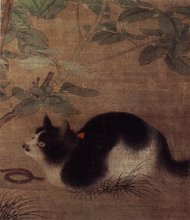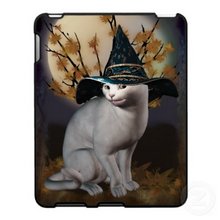Sacred Felines: History of the Cat Part 2

Zoals je gisteren hebt geleerd, is de kattengeschiedenis een veelzijdig en ingewikkeld onderwerp. Wat de wetenschap betreft, begon het vroegste teken van kat domesticatie in het oude Griekenland met de komst van agrarische samenlevingen. Later in de geschiedenis van de kat begonnen de oude Egyptenaren hen als goden te aanbidden, en voor het eerst in de geschiedenis van de kat kregen katachtigen een voorproefje van de koninklijke behandeling.
This history of the cat's worship began as a totemic practice, (the worship of an animal as a spiritual symbol) but was later further organized with the cat holding a legitimate spot in the Egyptian pantheon. There were three cat goddesses of note: Mafdet, Bast, and Sehkmet. Mafdet was the goddess of Justice. Bast began as a lion goddess but eventually became more cat-like as her role was marginalized. She was the protective patron deity of Lower Egypt, as well as a handmaiden and protector of the sun god, Ra. Sehkmet also began as a lioness, but ended up becoming more cat-like over time. She replaced Bast as the protector of Ra and the pharaohs.
Rond het jaar 390 voor Christus werd de belangrijkste cultus in het oude Egypte die katten aanbad, ontbonden, en katjes began to lose their significance, although their influence never completely fizzled out. Because of their awesome hunting skills, cats have always been valued residents of whatever culture and time period they happen to inhabit. Cat history is filled with owners thankful to be pest-free.
The history of the cat isn't limited to a single location though. They are valued companions all over the globe. During the Song Dynasty in China around a thousand years ago, cats were treated as the favored pets among nobility. They went so far as to advertise and sell fish exclusively for cat feeding in the ancient Chinese markets. In much of Europe and the United States, cats enjoyed a more
began to lose their significance, although their influence never completely fizzled out. Because of their awesome hunting skills, cats have always been valued residents of whatever culture and time period they happen to inhabit. Cat history is filled with owners thankful to be pest-free.
The history of the cat isn't limited to a single location though. They are valued companions all over the globe. During the Song Dynasty in China around a thousand years ago, cats were treated as the favored pets among nobility. They went so far as to advertise and sell fish exclusively for cat feeding in the ancient Chinese markets. In much of Europe and the United States, cats enjoyed a more infamous sort of notoriety. They became associated with witches as familiars and servants of the devil.
infamous sort of notoriety. They became associated with witches as familiars and servants of the devil.
This superstition persists in culture even today, as people will always assume a black cat crossing their path is an ill omen. Myths even include stories of cats sadistically smothering infant children by stealing all of the air from their noses. The crazy thing about that one is it may actually be rooted in reality. Cats have been known to lie on top of infant children for warmth, in some cases suffocating the child. However, in the United Kingdom it is considered good luck for a black cat to enter a home or climb aboard a ship. It seems human beings are often as ambivalent toward cats as they are towards us.
Het is duidelijk te zien dat kattengeschiedenis een rijk en gevarieerd onderwerp van studie is. Tijdens deze twee blogberichten hebben we nauwelijks het oppervlak van de vele verhalen en folklore rond onze favoriete katachtigen bekrast. Eén ding is zeker; of het nu gaat om slechte pers of voorkeursbehandeling, onze gecompliceerde relatie met deze katten eindigt niet snel.
This history of the cat's worship began as a totemic practice, (the worship of an animal as a spiritual symbol) but was later further organized with the cat holding a legitimate spot in the Egyptian pantheon. There were three cat goddesses of note: Mafdet, Bast, and Sehkmet. Mafdet was the goddess of Justice. Bast began as a lion goddess but eventually became more cat-like as her role was marginalized. She was the protective patron deity of Lower Egypt, as well as a handmaiden and protector of the sun god, Ra. Sehkmet also began as a lioness, but ended up becoming more cat-like over time. She replaced Bast as the protector of Ra and the pharaohs.
Rond het jaar 390 voor Christus werd de belangrijkste cultus in het oude Egypte die katten aanbad, ontbonden, en katjes
 began to lose their significance, although their influence never completely fizzled out. Because of their awesome hunting skills, cats have always been valued residents of whatever culture and time period they happen to inhabit. Cat history is filled with owners thankful to be pest-free.
began to lose their significance, although their influence never completely fizzled out. Because of their awesome hunting skills, cats have always been valued residents of whatever culture and time period they happen to inhabit. Cat history is filled with owners thankful to be pest-free.
 infamous sort of notoriety. They became associated with witches as familiars and servants of the devil.
infamous sort of notoriety. They became associated with witches as familiars and servants of the devil.This superstition persists in culture even today, as people will always assume a black cat crossing their path is an ill omen. Myths even include stories of cats sadistically smothering infant children by stealing all of the air from their noses. The crazy thing about that one is it may actually be rooted in reality. Cats have been known to lie on top of infant children for warmth, in some cases suffocating the child. However, in the United Kingdom it is considered good luck for a black cat to enter a home or climb aboard a ship. It seems human beings are often as ambivalent toward cats as they are towards us.
Het is duidelijk te zien dat kattengeschiedenis een rijk en gevarieerd onderwerp van studie is. Tijdens deze twee blogberichten hebben we nauwelijks het oppervlak van de vele verhalen en folklore rond onze favoriete katachtigen bekrast. Eén ding is zeker; of het nu gaat om slechte pers of voorkeursbehandeling, onze gecompliceerde relatie met deze katten eindigt niet snel.





 Alle berichten
Alle berichten Tips en trucs
Tips en trucs Gezondheid en welzijn
Gezondheid en welzijn Product beoordelingen
Product beoordelingen Grappig en eigenzinnig
Grappig en eigenzinnig





